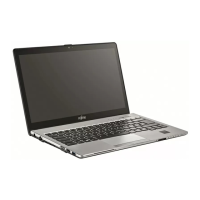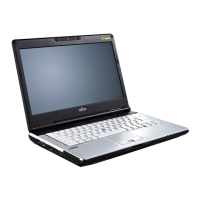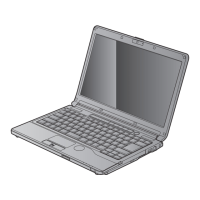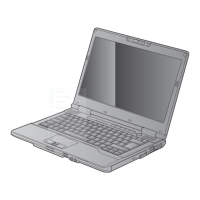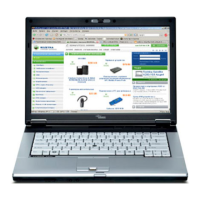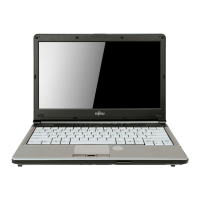Do you have a question about the Fujitsu LIFEBOOK S936 and is the answer not in the manual?
Details on drivers, OS compatibility, and software references.
Explains warning and information symbols and their meanings.
Explains font usage and key indicators in the manual.
Identifies front-facing ports and controls with numbered labels.
Identifies left-side ports and controls with numbered labels.
Identifies right-side ports and controls with numbered labels.
Identifies bottom-side ports and features with numbered labels.
Essential safety information for notebook operation and handling.
Specific safety guidelines for devices with wireless components.
How to use power management features within Windows.
Guidelines for data backup, radio components, and international travel.
Precautions for safely transporting the notebook to prevent damage.
Instructions for cleaning the device, emphasizing safe products and methods.
Steps for unpacking and checking the notebook for transit damage.
Guidelines for choosing a safe and suitable place to set up the notebook.
Instructions on how to connect the power adapter to the notebook.
Procedure for the first power-on and software installation.
Explains the meaning of various status LEDs and the battery button.
Explains the function of power-on and battery charging status LEDs.
Details the states and meanings of the first battery status indicator.
Explains indicators for second battery, drive access, and Num Lock status.
Explains indicators for Caps Lock, Scroll Lock, wireless components, and ECO mode.
Step-by-step guide to powering on the notebook.
Procedure for safely shutting down the notebook.
Details the function and use of the dedicated ECO button.
Guide to using the touchpad and its buttons for navigation and interaction.
How to move the pointer, select items, and execute commands using the touchpad.
Instructions for dragging items and enabling/disabling the touchpad.
Details on LCD screen quality, resolution, and pixel specifications.
Explains touch gestures and notebook camera usage.
Explains the notebook keyboard layout and character input.
Details the function of individual keys like Backspace, Enter, Shift, etc.
How to use the on-screen numeric keypad.
Lists and explains useful keyboard shortcuts for various functions.
How to configure regional and keyboard language settings.
Guidelines for charging, storage, and maintaining battery health.
Step-by-step instructions for battery removal and insertion.
Lists available modules for the module bay: battery, optical drive, HDD.
Procedure for inserting a module into the module bay.
Warning about optical drive laser and data carrier handling.
Explains drive indicator and steps for inserting/ejecting data carriers.
Procedure for emergency removal of a data carrier.
How to use power-management features to extend battery life.
Lists supported memory card formats and how to insert/remove them.
Information on the notebook's audio output and input devices.
Instructions for inserting and removing a SIM card for mobile network access.
Lists wireless technologies and how to switch them on/off.
Steps to configure and connect to a Wireless LAN network.
Information on the optional Near Field Communication feature.
How to connect to the internet using UMTS/LTE modules or devices.
How to establish a wired network connection using Ethernet LAN.
Identifies ports and controls on the optional port replicator.
Procedure for docking the notebook to the port replicator.
Connecting power and switching on the notebook via the replicator.
Procedures for shutting down and undocking the notebook from the replicator.
Introduction to the notebook's various security features.
How to set up and use the palm vein sensor for authentication.
How to set up and use the fingerprint sensor for authentication.
Instructions for attaching and using a Kensington lock for physical security.
How to configure supervisor and user passwords in the BIOS.
Detailed steps for setting supervisor and user passwords in BIOS.
Steps to remove BIOS passwords and enable system boot protection.
How to set up and manage passwords for hard disk access.
Configuring BIOS to allow booting from external devices.
Entering personal information displayed during boot.
How to enable or disable the TPM for enhanced security.
Information about using SmartCards for authentication and security.
Steps to insert a SmartCard into the reader.
How to connect external monitors to the notebook and port replicator.
Guide to connecting monitors via the notebook's VGA port.
Guide to connecting monitors via DisplayPort or DVI-D on the replicator.
How to connect devices via HDMI and USB ports.
Details on using USB ports for charging and safely removing USB devices.
How to connect headsets, headphones, microphones, and speakers.
Warnings about unauthorized repairs and handling internal components.
Steps to take before removing or changing system components.
Instructions for installing and removing memory modules.
Steps to remove the notebook cover and memory modules.
Steps to install memory modules and reattach the notebook cover.
Explains the purpose and menus of the BIOS Setup Utility.
How to access and navigate the BIOS Setup Utility.
Options for saving changes, discarding changes, and exiting the BIOS.
General steps to take when a fault occurs and seeking help.
How to reinstall the operating system and drivers.
Solutions for incorrect system date/time or unintended numeric keyboard input.
Solutions for blank or unreadable LCD screens and external monitor problems.
Troubleshooting for when the notebook fails to start or stops working.
Solutions for printer connection problems and wireless network failures.
Troubleshooting for SmartCard recognition, lost cards, and forgotten passwords.
Lists common BIOS error messages and their resolutions.
Details ambient conditions, dimensions, weight, and memory for the LIFEBOOK.
Technical details for the optional port replicator, including electrical data and ambient conditions.
Technical data for the rechargeable battery and mains adapter.
Information on environmentally responsible disposal of the notebook.
Compliance documents and information related to EU directives and radio components.
Lists RF frequencies and includes FCC, Industry Canada, and other regulatory compliance info.
